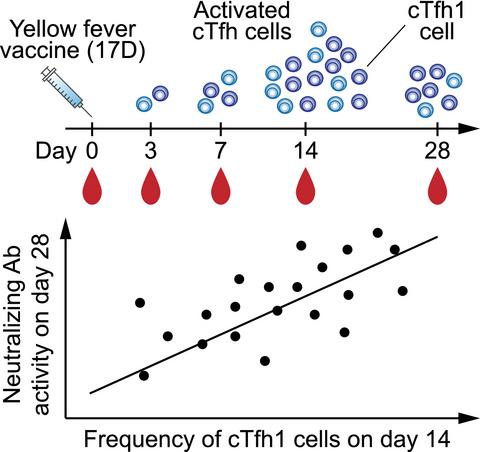当前位置:
X-MOL 学术
›
Clin. Transl. Immunol.
›
论文详情
Our official English website, www.x-mol.net, welcomes your
feedback! (Note: you will need to create a separate account there.)
Dynamic changes in circulating T follicular helper cell composition predict neutralising antibody responses after yellow fever vaccination.
Clinical & Translational Immunology ( IF 4.6 ) Pub Date : 2020-05-13 , DOI: 10.1002/cti2.1129 Johanna E Huber 1 , Julia Ahlfeld 2, 3, 4 , Magdalena K Scheck 2 , Magdalena Zaucha 2 , Klaus Witter 5 , Lisa Lehmann 2 , Hadi Karimzadeh 2, 3 , Michael Pritsch 6 , Michael Hoelscher 6, 7 , Frank von Sonnenburg 6 , Andrea Dick 5 , Giovanna Barba-Spaeth 8 , Anne B Krug 1 , Simon Rothenfußer 2, 3 , Dirk Baumjohann 1, 9
Clinical & Translational Immunology ( IF 4.6 ) Pub Date : 2020-05-13 , DOI: 10.1002/cti2.1129 Johanna E Huber 1 , Julia Ahlfeld 2, 3, 4 , Magdalena K Scheck 2 , Magdalena Zaucha 2 , Klaus Witter 5 , Lisa Lehmann 2 , Hadi Karimzadeh 2, 3 , Michael Pritsch 6 , Michael Hoelscher 6, 7 , Frank von Sonnenburg 6 , Andrea Dick 5 , Giovanna Barba-Spaeth 8 , Anne B Krug 1 , Simon Rothenfußer 2, 3 , Dirk Baumjohann 1, 9
Affiliation

|
Objectives
T follicular helper (Tfh) cells are the principal T helper cell subset that provides help to B cells for potent antibody responses against various pathogens. In this study, we took advantage of the live-attenuated yellow fever virus (YFV) vaccine strain, YF-17D, as a model system for studying human antiviral immune responses in vivo following exposure to an acute primary virus challenge under safe and highly controlled conditions, to comprehensively analyse the dynamics of circulating Tfh (cTfh) cells.
Methods
We tracked and analysed the response of cTfh and other T and B cell subsets in peripheral blood of healthy volunteers by flow cytometry over the course of 4 weeks after YF-17D vaccination.
Results
Using surface staining of cell activation markers to track YFV-specific T cells, we found increasing cTfh cell frequencies starting at day 3 and peaking around 2 weeks after YF-17D vaccination. This kinetic was confirmed in a subgroup of donors using MHC multimer staining for four known MHC class II epitopes of YF-17D. The subset composition of cTfh cells changed dynamically during the course of the immune response and was dominated by the cTfh1-polarised subpopulation. Importantly, frequencies of cTfh1 cells correlated with the strength of the neutralising antibody response, whereas frequencies of cTfh17 cells were inversely correlated.
Conclusion
In summary, we describe detailed cTfh kinetics during YF-17D vaccination. Our results suggest that cTfh expansion and polarisation can serve as a prognostic marker for vaccine success. These insights may be leveraged in the future to improve current vaccine design and strategies.
中文翻译:

循环 T 滤泡辅助细胞组成的动态变化预测黄热病疫苗接种后的中和抗体反应。
目的 T 滤泡辅助 (Tfh) 细胞是主要的 T 辅助细胞亚群,可帮助 B 细胞对各种病原体产生有效的抗体反应。在这项研究中,我们利用黄热病病毒 (YFV) 减毒活疫苗株 YF-17D 作为模型系统,在安全和高度控制的情况下研究暴露于急性原发性病毒挑战后的体内人类抗病毒免疫反应条件下,全面分析循环 Tfh (cTfh) 细胞的动力学。方法 我们在 YF-17D 疫苗接种后的 4 周内通过流式细胞术跟踪和分析健康志愿者外周血中 cTfh 和其他 T 和 B 细胞亚群的反应。结果 使用细胞活化标记的表面染色来追踪 YFV 特异性 T 细胞,我们发现 cTfh 细胞频率从第 3 天开始增加,并在 YF-17D 疫苗接种后 2 周左右达到峰值。使用 MHC 多聚体染色对 YF-17D 的四个已知 MHC II 类表位在一个供体亚组中证实了这种动力学。cTfh 细胞的亚群组成在免疫反应过程中动态变化,并由 cTfh1 极化亚群主导。重要的是,cTfh1 细胞的频率与中和抗体反应的强度相关,而 cTfh17 细胞的频率呈负相关。结论 总之,我们描述了 YF-17D 疫苗接种期间的详细 cTfh 动力学。我们的结果表明,cTfh 扩增和极化可以作为疫苗成功的预后标志物。未来可能会利用这些见解来改进当前的疫苗设计和策略。
更新日期:2020-05-13
中文翻译:

循环 T 滤泡辅助细胞组成的动态变化预测黄热病疫苗接种后的中和抗体反应。
目的 T 滤泡辅助 (Tfh) 细胞是主要的 T 辅助细胞亚群,可帮助 B 细胞对各种病原体产生有效的抗体反应。在这项研究中,我们利用黄热病病毒 (YFV) 减毒活疫苗株 YF-17D 作为模型系统,在安全和高度控制的情况下研究暴露于急性原发性病毒挑战后的体内人类抗病毒免疫反应条件下,全面分析循环 Tfh (cTfh) 细胞的动力学。方法 我们在 YF-17D 疫苗接种后的 4 周内通过流式细胞术跟踪和分析健康志愿者外周血中 cTfh 和其他 T 和 B 细胞亚群的反应。结果 使用细胞活化标记的表面染色来追踪 YFV 特异性 T 细胞,我们发现 cTfh 细胞频率从第 3 天开始增加,并在 YF-17D 疫苗接种后 2 周左右达到峰值。使用 MHC 多聚体染色对 YF-17D 的四个已知 MHC II 类表位在一个供体亚组中证实了这种动力学。cTfh 细胞的亚群组成在免疫反应过程中动态变化,并由 cTfh1 极化亚群主导。重要的是,cTfh1 细胞的频率与中和抗体反应的强度相关,而 cTfh17 细胞的频率呈负相关。结论 总之,我们描述了 YF-17D 疫苗接种期间的详细 cTfh 动力学。我们的结果表明,cTfh 扩增和极化可以作为疫苗成功的预后标志物。未来可能会利用这些见解来改进当前的疫苗设计和策略。











































 京公网安备 11010802027423号
京公网安备 11010802027423号